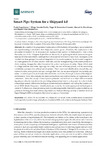Mostrar o rexistro simple do ítem
Smart Pipe System for a Shipyard 4.0
| dc.contributor.author | Fraga-Lamas, Paula | |
| dc.contributor.author | Noceda-Davila, Diego | |
| dc.contributor.author | Fernández-Caramés, Tiago M. | |
| dc.contributor.author | Díaz-Bouza, Manuel A. | |
| dc.contributor.author | Vilar-Montesinos, Miguel A. | |
| dc.date | 2016 | |
| dc.date.accessioned | 2017-05-02T11:09:56Z | |
| dc.date.available | 2017-05-02T11:09:56Z | |
| dc.date.issued | 2016 | |
| dc.identifier.citation | Sensors 2016, Vol. 16, Page 2186 | es_ES |
| dc.identifier.issn | 1424-8220 | |
| dc.identifier.uri | http://hdl.handle.net/2183/18472 | |
| dc.description.abstract | [Abstract] As a result of the progressive implantation of the Industry 4.0 paradigm, many industries are experimenting a revolution that shipyards cannot ignore. Therefore, the application of the principles of Industry 4.0 to shipyards are leading to the creation of Shipyards 4.0. Due to this, Navantia, one of the 10 largest shipbuilders in the world, is updating its whole inner workings to keep up with the near-future challenges that a Shipyard 4.0 will have to face. Such challenges can be divided into three groups: the vertical integration of production systems, the horizontal integration of a new generation of value creation networks, and the re-engineering of the entire production chain, making changes that affect the entire life cycle of each piece of a ship. Pipes, which exist in a huge number and varied typology on a ship, are one of the key pieces, and its monitoring constitutes a prospective cyber-physical system. Their improved identification, traceability, and indoor location, from production and through their life, can enhance shipyard productivity and safety. In order to perform such tasks, this article first conducts a thorough analysis of the shipyard environment. From this analysis, the essential hardware and software technical requirements are determined. Next, the concept of smart pipe is presented and defined as an object able to transmit signals periodically that allows for providing enhanced services in a shipyard. In order to build a smart pipe system, different technologies are selected and evaluated, concluding that passive and active RFID (Radio Frequency Identification) are currently the most appropriate technologies to create it. Furthermore, some promising indoor positioning results obtained in a pipe workshop are presented, showing that multi-antenna algorithms and Kalman filtering can help to stabilize Received Signal Strength (RSS) and improve the overall accuracy of the system. | es_ES |
| dc.description.abstract | [Resumen] Como resultado de la implantación progresiva del paradigma de la industria 4.0, muchas industrias están experimentando una revolución que los astilleros no pueden ignorar. Por lo tanto, la aplicación de los principios de la Industria de 4,0 a astilleros están dando lugar a la creación de astilleros 4.0. Debido a esto, Navantia, uno de los 10 constructores de barcos más grandes del mundo, es la actualización de su funcionamiento interno enteros para mantenerse al día con los desafíos del futuro próximo que un astillero 4.0 tendrá que hacer frente. Tales desafíos se pueden dividir en tres grupos: la integración vertical de los sistemas de producción, la integración horizontal de una nueva generación de redes de creación de valor, y la reingeniería de toda la cadena de producción, por lo que los cambios que afectan a todo el ciclo de vida de cada pieza de un barco. Tuberías, que existen en un gran número y tipología variada en un barco, son una de las piezas clave, y su seguimiento constituye un sistema ciberfísicos prospectivo. Su identificación, trazabilidad y localización en interiores, desde la producción ya través de su vida, puede mejorar la productividad y la seguridad en los astilleros mejorado. Para llevar a cabo tales tareas, este artículo lleva a cabo primero un análisis exhaustivo del medio ambiente astillero. A partir de este análisis, se determinan los requisitos técnicos esenciales de hardware y software. A continuación, el concepto de tubo inteligente se presenta y se define como un objeto capaz de transmitir señales periódicamente que permite proporcionar servicios mejorados en un astillero. Con el fin de construir un sistema de tuberías inteligente, diferentes tecnologías son seleccionados y evaluados, llegando a la conclusión de que la RFID pasiva y activa (identificación por radiofrecuencia) son actualmente las tecnologías más adecuadas para crearlo. Por otra parte, se presentan algunos resultados prometedores obtenidos de posicionamiento en interiores en un taller de la tubería, lo que demuestra que los algoritmos de múltiples antenas y filtrado de Kalman pueden ayudar a estabilizar intensidad de señal recibida (RSS) y mejorar la precisión global del sistema. | es_ES |
| dc.language.iso | eng | es_ES |
| dc.publisher | Multidisciplinary Digital Publishing Institute | es_ES |
| dc.relation.uri | http://dx.doi.org/10.3390/s16122186 | es_ES |
| dc.rights | Reconocimiento 4.0 (CC BY) | es_ES |
| dc.rights.uri | https://creativecommons.org/licenses/by/4.0/ | |
| dc.subject | IoT | es_ES |
| dc.subject | Wi-Fi | es_ES |
| dc.subject | Industry 4.0 | es_ES |
| dc.subject | Shipyard 4.0 | es_ES |
| dc.subject | Smart pipes | es_ES |
| dc.subject | Identification | es_ES |
| dc.subject | Localization | es_ES |
| dc.subject | Tracking | es_ES |
| dc.subject | Indoor positioning | es_ES |
| dc.subject | Cyber-physical systems | es_ES |
| dc.subject | RSS | es_ES |
| dc.subject | Multi-antenna techniques | es_ES |
| dc.subject | Kalman filter | es_ES |
| dc.title | Smart Pipe System for a Shipyard 4.0 | es_ES |
| dc.type | info:eu-repo/semantics/article | es_ES |
| dc.rights.access | info:eu-repo/semantics/openAccess | es_ES |
| UDC.journalTitle | Sensors | es_ES |
| UDC.volume | 16 | es_ES |
| UDC.issue | 12 | es_ES |
| UDC.startPage | 2186 | es_ES |
Ficheiros no ítem
Este ítem aparece na(s) seguinte(s) colección(s)
-
GI-GTEC - Artigos [186]






